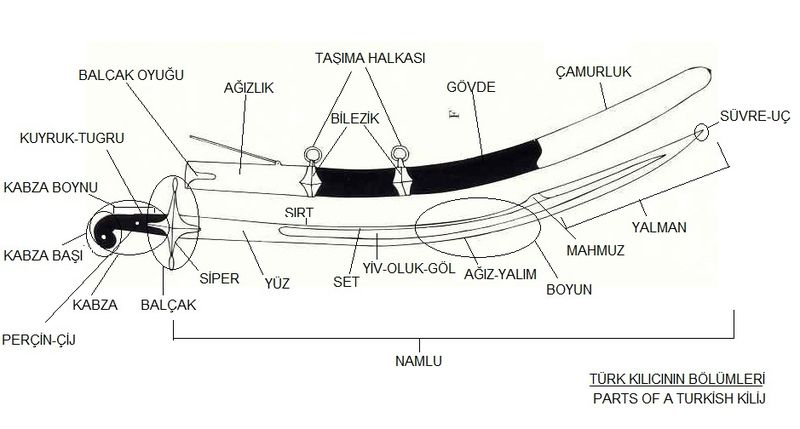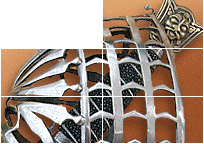| Author |
Message |
|
Sage Lawler
Location: New Zealand Joined: 09 Jul 2013
Posts: 4
|
 Posted: Tue 09 Jul, 2013 3:09 am Post subject: 16th Century Russian Weapons Posted: Tue 09 Jul, 2013 3:09 am Post subject: 16th Century Russian Weapons |
 |
|
I'm getting some 16th century Russian Armour made for myself for battle of the nations and i need some weapons to go with it but I'm not really sure what to use and was wondering if anyone could give me any advise also any pictures would be great.
thanks Sage
|
|
   |
 |
Andris Auzins

Location: Riga, Latvia Joined: 29 Nov 2007
Posts: 9
|
 Posted: Tue 09 Jul, 2013 5:00 am Post subject: Posted: Tue 09 Jul, 2013 5:00 am Post subject: |
 |
|
|
Get a falchion. Russians love falchions.
|
|
  |
 |
|
Sage Lawler
Location: New Zealand Joined: 09 Jul 2013
Posts: 4
|
 Posted: Tue 09 Jul, 2013 5:19 am Post subject: Posted: Tue 09 Jul, 2013 5:19 am Post subject: |
 |
|
| Andris Auzins wrote: | | Get a falchion. Russians love falchions. |
Haha they do, but im more after the different types of Russian falchions and other weapons so i can choose what im going to get made
|
|
   |
 |
|
Alex Indman
|
 Posted: Tue 09 Jul, 2013 7:23 am Post subject: Posted: Tue 09 Jul, 2013 7:23 am Post subject: |
 |
|
From what I have seen in Russian museums and books, the most common weapons set for a XVIc Russian armored horseman (since you are getting armor made, it pretty much means at least a minor noble and a horseman) would be:
- an eastern (Turkish most common) type of curved sword. Could be of actual Turkish or Persian manufacture, or locally made but not much different. This was practically the only type of sword used by Russians at the time, not only by horsemen but by infantry as well, even by matchlock musketiers ("streltsi"). So you must get one to wear with your armor.
- one or two daggers (belt and boot top pretty common), also of slightly curved eastern type.
- Tatar/Turkish type of bow, carried Tatar style in a "saadak" (bow case with a quiver together).
- short war hammer ("chekan") possible as a backup weapon.
- short war flail ("kisten", with about a foot long handle, same length chain, small iron head, carried stuck under the belt at the back) very common as a backup weapon.
- later in the century (and for more noble/rich persons) one or two imported Western European saddle pistols (wheellocks, of course) are possible.
- spear possible (relatively short and stout, not like Western European lance).
Does that answer your question?
Alex.
|
|
  |
 |
|
Sage Lawler
Location: New Zealand Joined: 09 Jul 2013
Posts: 4
|
 Posted: Tue 09 Jul, 2013 5:07 pm Post subject: Posted: Tue 09 Jul, 2013 5:07 pm Post subject: |
 |
|
Very Helpful! thank you.
Does anyone have any links to pictures of collections of Russian weapons?
|
|
   |
 |
David Lewis Smith

|
 Posted: Tue 09 Jul, 2013 7:41 pm Post subject: Posted: Tue 09 Jul, 2013 7:41 pm Post subject: |
 |
|
I will not be home for about a week. send me a PM to remind me and I will try to post photos from my library.
Do you read russian? if not I will translate.
David L Smith
MSG (RET)
|
|
   |
 |
|
Alex Indman
|
|
  |
 |
Bartek Strojek

|
 Posted: Wed 10 Jul, 2013 7:43 am Post subject: Posted: Wed 10 Jul, 2013 7:43 am Post subject: |
 |
|
You can try googling/whatever "Battle of Orsza" or "Bitwa pod Orszą", there are quite a few very high resolution pictures out there, so showing a lot of details.
http://img829.imageshack.us/img829/8153/orsza2.jpg
Russian boyars appear to have a lot of bows and what appears to be buff textile armor, with some mail from time to time. And what appears to be bechters or lammellar armor.
http://enroutepictures2.files.wordpress.com/2...rsza11.jpg
Historians dispute on how exactly accurate those presentations are, but it's something to look at, I guess.
|
|
  |
 |
Boris Bedrosov
Industry Professional

Location: Bourgas, Bulgaria Joined: 06 Nov 2005
Posts: 700
|
 Posted: Wed 10 Jul, 2013 1:11 pm Post subject: Posted: Wed 10 Jul, 2013 1:11 pm Post subject: |
 |
|
Hi all forum-mates!
I've not been here for a long, long time.....
Sage,
Regarding the armour (if it's not made yet) I would suggest you Zertsalo (or sometimes called Krug) armour, with construction like this particular one
[ Linked Image ]
belonged to Tsar Michail Fiyodorovich Romanov (1596—1645).
As you see, this example is a little bit later, compared with your period of interests, but just bear in mind that as a type it's common from the 1550s onwards.
Also, note that the construction is quite different from the Ottoman Zertsalos - overlapping plates, connected with leather straps from the inside, instead of not-overlapping plates, connected with straps of maille.
"Everyone who has the right to wear a long sword, has to remember that his sword is his soul,
and he has to separate from it when he separates from his life"
Tokugawa Ieyasu
Find my works on Facebook:
Boris Bedrosov's Armoury
|
|
   |
 |
Bennison N

|
 Posted: Wed 10 Jul, 2013 2:43 pm Post subject: Posted: Wed 10 Jul, 2013 2:43 pm Post subject: |
 |
|
That's actually the exact one he wants!
He's in lust with Bryce Lightbody of BotN Australia's kit (based on this one), right Sage?
I hope he gets it... I want to hit it. :) Over and over. Both his and Bryce's.
Get a sabre, Sage. A shorter one, with a pronounced yelman. That will hit with energy somewhat comparable to the falchions.
Just remember the rules - 2mm minimum edge, and 1 euro coin point. One-handers have to be less than 1600g, as far as I remember.
"Never give a sword to a man who can't dance" - Confucius
अजयखड्गधारी
|
|
  |
 |
|
Sage Lawler
Location: New Zealand Joined: 09 Jul 2013
Posts: 4
|
 Posted: Wed 10 Jul, 2013 5:45 pm Post subject: Posted: Wed 10 Jul, 2013 5:45 pm Post subject: |
 |
|
Haha yeah that is the one im getting made for me.
Nathan do you have any pics of yelman?
|
|
   |
 |
Bennison N

|
 Posted: Thu 11 Jul, 2013 12:08 am Post subject: Posted: Thu 11 Jul, 2013 12:08 am Post subject: |
 |
|
Sure thing, Mate!
Here are the Turkish names for the anatomy of a Kilic/Kilij.
The yelman, here called yalman with an A, is the last part of the Kilic blade towards the point. It has a false edge, and is thicker, to bring the balance of the sword out towards the point.
These swords are really good at cutting. So with a rebated edge, it'll be really good at bludgeoning. :D
 Attachment: 44.53 KB Attachment: 44.53 KB

Parts of a Kilic.
"Never give a sword to a man who can't dance" - Confucius
अजयखड्गधारी
|
|
  |
 |
|
|

